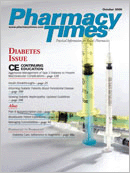Publication
Article
Pharmacy Times
HYPERTENSION WATCH
High Blood Pressure Can Lower Fat Metabolism
According to research published in the June 2006 issueof the Journal of Nuclear Cardiology, the hearts of patientswith muscle thickening (hypertrophy) due to high bloodpressure (BP) have an energy metabolism that fails to usefat as energy. Researchers from Washington Universityexplained that these hearts get less energy because of theirreduced fat metabolism, which leads them to rely moreheavily on carbohydrates, which produce less energy permolecule than fatty acids.
"With hypertrophy, the heart has a higher energydemand because there's more muscle to feed," theinvestigators explained. "With less fat metabolism, agreater reliance on carbohydrates may represent a shiftto a less-efficient fuel."
The researchers studied patients who had high BPthat led to hypertrophy and found that the greater themuscle mass of the hypertrophic heart the lower theability to burn fat. A normal heart muscle alternatesbetween using fats and carbohydrates as fuel, dependingon availability. When people with a hypertrophicheart experience low blood sugar, however, their heartscannot switch to fatty acids as normal hearts would,leaving them energy-deficient.
Low-fat Dairy Could Help Lower BP
According to a report published in the August 2006 issue ofHypertension: Journal of the American Heart Association, eatinglow-fat dairy products could help lower blood pressure (BP).The researchers used data from food questionnaires filled outby 4797 men and women who were participating in theNational Heart, Lung, and Blood Institute's Family Heart Study.The participants had an average age of 52 years. They wereenrolled in the study to help determine genetic and nongeneticcauses of coronary heart disease, atherosclerosis, and cardiovascularrisk factors, such as hypertension.
The researchers, led by Luc Djoussé, MD, MPh, DSc, of theDivision of Aging at Brigham and Women's Hospital and HarvardMedical School, Boston, Mass, found that those who ate moredairy products had lower systolic BP. When divided into groupsbased on the number of servings eaten daily, those who ate themost had systolic BP readings of 2.6 mm Hg lower than thosewho ate the fewest. These people also had a 36% lower chanceof having high BP. The greatest positive effects, however, wereshown in those who ate dairy products with the lowest amountof saturated fats. In these groups, those who consumed moredairy products (with less fat) had systolic BP readings of 3.5 mmHg lower and had a 54% lower chance of having high BP thanthose who ate fewer.
Hypertension Could Limit Walking Ability in Seniors
The findings of a study by researchers at RushUniversity Medical Center in Chicago, Ill, suggest thathigher blood pressure (BP) could be linked to a decline inwalking ability as patients get older. The study resultswere published in the August 2006 issue of the Journalof Gerontology: Medical Sciences.
Researchers studied 888 elderly Catholic clergy whoare participating in the Religious Orders Study. The investigatorsmeasured the participants' BP at baseline,established the presence of vascular diseases and diabetes,assessed cognitive function, and noted medications.They assessed gait and balance throughout thestudy using performance-based tasks, including the timeand number of steps taken to walk 8 feet, the time to situp and down 5 times, and the ability to stand with eyesopen and eyes closed.
Controlling for age and gender, the researchers foundthat a 10-mm Hg increase in systolic BP was associatedwith a greater decline in lower limb function. On average,lower limb function was reduced 28.7% faster inpatients with a systolic BP of 160 mm Hg than in thosewith a normal systolic reading.
Exercise Encouraged to Reduce Hypertension
A US study has reinforced the benefitsof exercise in seniors with mildlyhigh blood pressure (BP). These patientsshould be cautious, however,because exercise tends to raise BP initiallyand could lead to adverse cardiaceffects. Elderly patients should consultwith their physicians before taking upany form of exercise.
Researchers at Johns Hopkins UniversitySchool of Medicine in Baltimore,Md, performed the analysis. They studiedthe effects of exercise on cardiac size andleft ventricular function of older men andwomen participating in the Senior Hypertensionand Physical Exercise (SHAPE)study. The patients were randomlyassigned either to participate or not to participatein supervised exercise for 1 hour aday 3 times a week.
After 6 months, those who exercisedhad higher peak oxygen intake on atreadmill, greater strength, and lowerbody fat, diastolic BP, and insulin resistancethan those who did not exercise.The results of the study were publishedin the July 2006 edition of Heart.







